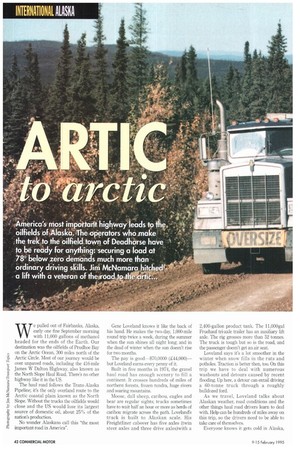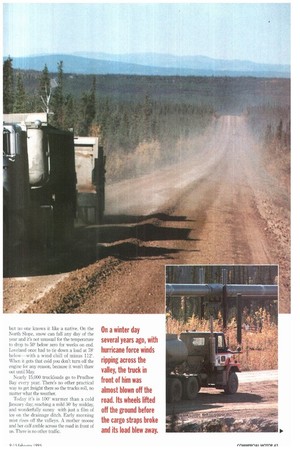America's most important highway leads to 'lie. oilfields of Alaska.
Page 46

Page 47

If you've noticed an error in this article please click here to report it so we can fix it.
The operators who make the trek to the oilfield town of Deadhorse have to be ready for anything: securing a load at 78' below zero demands much more than ordinary driving skills. Jim McNamara. hitche a lift with a veteran of theiroad.t9 ihrarik: We pulled out of Fairbanks, Alaska, early one fine September morning with 11,000 gallons of methanol headed for the ends of the Earth. Our destination was the oilfields of Prudhoe Bay on the Arctic Ocean, 300 miles north of the Arctic Circle. Most of our journey would be over unpaved roads, including the 416-mile James W Dalton Highway, also known as the North Slope Haul Road. There's no other highway like it in the US.
The haul road follows the Trans-Alaska Pipeline; it's the only overland route to the Arctic coastal plain known as the North Slope. Without the trucks the oilfields would close and the US would lose its largest source of domestic oil, about 25% of the nation's production.
No wonder Alaskans call this "the most important road in America". Gene Loveland knows it like the back of his hand. He makes the two-day, 1,000-mile round trip twice a week, during the summer when the sun shines all night long; and in the dead of winter when the sun doesn't rise for two months.
The pay is good—$70,0000 (44,000)— but Loveland earns every penny of it.
Built in five months in 1974, the gravel haul road has enough scenery to fill a continent. It crosses hundreds of miles of northern forests, frozen tundra, huge rivers and soaring mountains.
Moose, dall sheep, caribou, eagles and bear are regular sights; trucks sometimes have to wait half an hour or more as herds of caribou migrate across the path. Loveland's truck is built to Alaskan scale. His Freightliner cabover has five axles (twin steer axles and three drive axles)with a 2,400-gallon product tank. The 11,000gal Fruehauf tri-axle trailer has an auxiliary lift axle The rig grosses more than 52 tonnes. The truck is tough but so is the road, and the passenger doesn't get an air seat.
Loveland says it's a lot smoother in the winter when snow fills in the ruts and potholes. Traction is better then, too. On this trip we have to deal with numerous washouts and detours caused by recent flooding. Up here, a detour can entail driving a 60-tonne truck through a roughly bulldozed ford.
As we travel, Loveland talks about Alaskan weather, road conditions and the other things haul road drivers learn to deal with. Help can be hundreds of miles away on this trip, so the drivers need to be able to take care of themselves.
Everyone knows it gets cold in Alaska, but no one knows it like a native. On the North Slope, snow can fall any day of the year and its not unusual for the temperature to drop to 517P below zero for weeks on end. Loveland once had to tie down a load at 78' below—with a wind chill of minus 112. When it gets that cold you don't turn off the engine for any reason, because it won't thaw out until May.
Nearly 15,000 truckloads go to Prudhoe Bay every year. There's no other practical way to get freight there so the trucks roll, no matter what the weather.
Today it's is 100" warmer than a cold January day; reaching a mild 50 by midday, and wonderfully sunny with just a film of ice on the drainage ditch. Early morning mist rises off the valleys. A mother moose and her calf amble across the road in front of us. There is no other traffic.


































































































